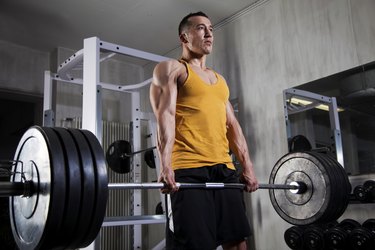
Powerlifting, a strength sport where you compete in the squat, bench press and deadlift, allows you to build muscle and burn fat. Powerlifting, like other forms of heavy resistance training, strengthens your skeleton and reduces your risk of injury in other sports and activities. While the rules for the powerlifts remain specific, the general benefits of powerlifting go far beyond conventional lifting. Consult a health care practitioner before beginning any strength training program.
Improved Strength
Video of the Day
Powerlifting strengthens the muscles of your legs, back and upper body. Nearly every skeletal muscle is strengthened with a powerlifting routine. The squat works the muscles of your legs and hips better than many other training alternatives, according to a 2001 study published in "Medicine & Science in Sports & Exercise." The deadlift strengthens your back and legs, and the bench press strengthens most of the muscles of your upper body. The few muscles that are not worked directly on these three exercises are trained using assistance exercises to improve the three competitive lifts.
Video of the Day
Fat Loss
Powerlifting is a very intense form of exercise and burns a great many calories. One of the benefits of intense training is not just the calories you burn while training, but the long-term effect this has on your metabolism. In a 1994 study published in the "American Journal of Clinical Nutrition," study participants undergoing resistance training increased their caloric demands over a 24-hour period by 15 percent. Resistance training such as powerlifting has long been shown to be effective for fat loss.
Skeletal Health
Osteoporosis afflicts one out of every five women in the United States. Fortunately, resistance training can combat the onset of osteoporosis. In a 10-year review of literature published in "Medicine & Science in Sports & Exercise" in 1999, it was shown that resistance training specifically increases bone mineral density. It was further shown that intense resistance training, such as powerlifting, decreases numerous risk factors for osteoporosis by increasing strength and bone mass.
Athletic Ability
Many of the activities in powerlifting improve other abilities, including speed and vertical jump. In a 2004 study published in the "British Journal of Sports Medicine," a direct correlation between squat strength and sprint speed was shown. There was also a direct correlation between squat strength and vertical leap. So if you want to run faster or jump higher, build a bigger squat through powerlifting. The strength of your back contributes to many other activities, including martial arts, wrestling and fighting. There are few activities that being strong does not help in one way or another.
- ""Medicine and Science in Sports and Exercise"; Effects of Technique Variations on Knee Biomechanics During the Squat and Leg Press; R.F. Escamilla, et al.; September 2001
- "American Journal of Clinical Nutrition"; Increased Energy Requirements and Changes in Body Composition with Resistance Training in Older Adults; W.W. Campbell, et al.; August 1994
- "Journal of Obesity"; Evidence for Resistance Training as a Treatment Therapy in Obesity; B Strasser, et al.; August 2011
- "Medicine and Science in Sports and Exercise"; The Effects of Progressive Resistance Training on Bone Density; J.E. Layne, et al.; January 1999
- "British Journal of Sports Medicine"; Strong Correlation of Maximal Squat Strength with Sprint Performance and Vertical Jump Height in Elite Soccer Players; U. Wisloff, et al.; June 2004